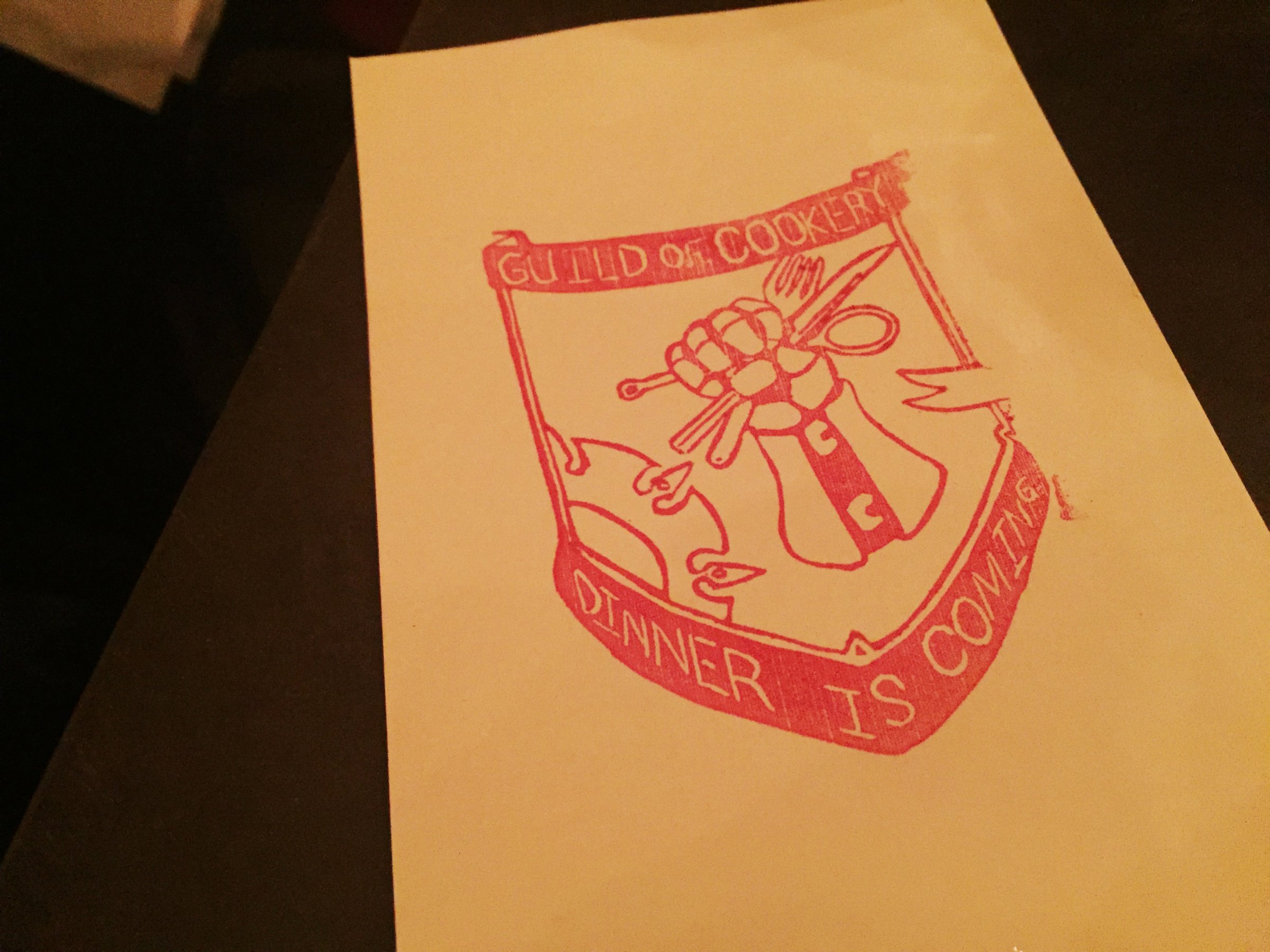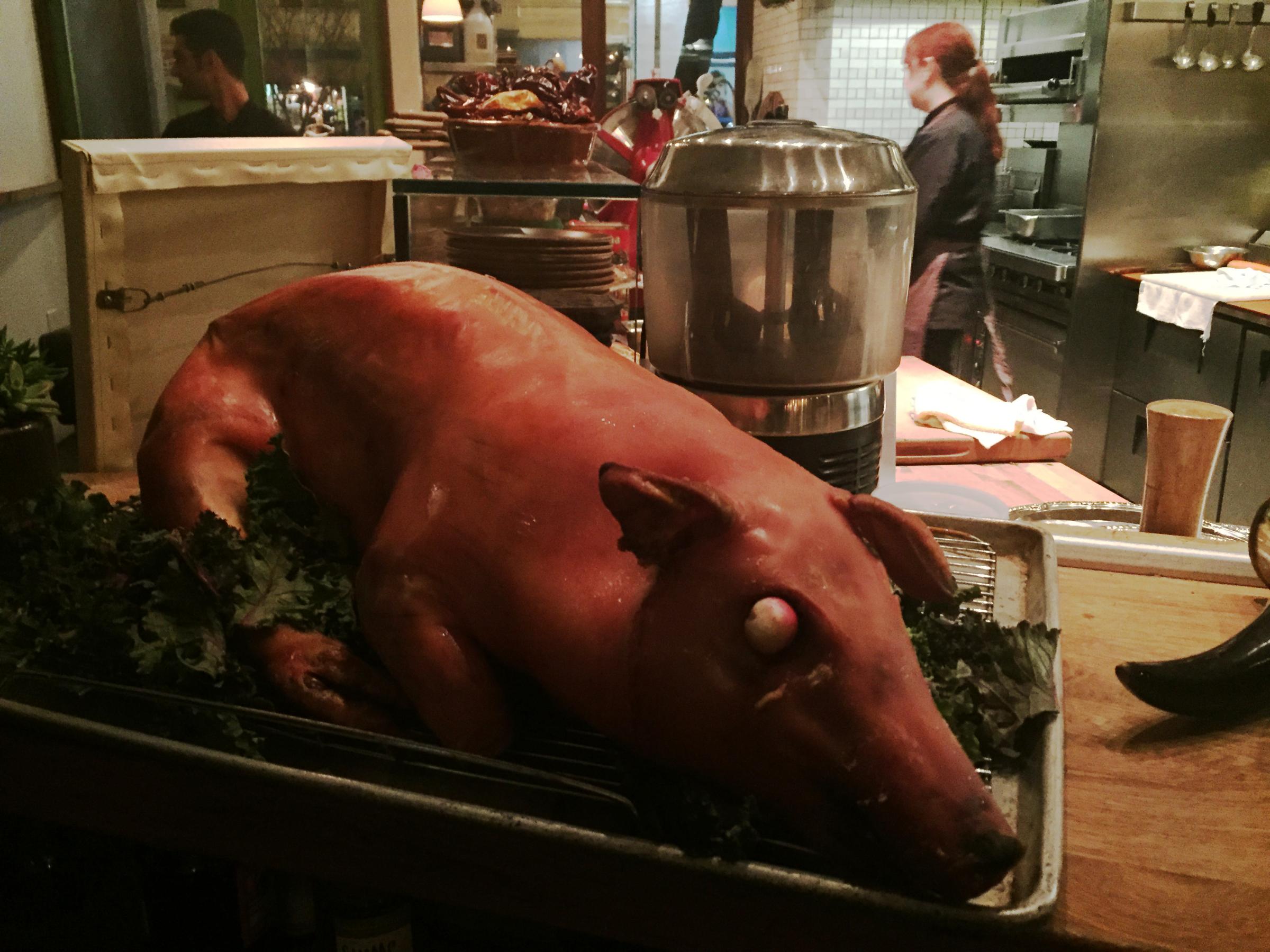
Their sigil is an armored hand clutching cutlery. Their house motto is as tantalizing as it is obvious: “Dinner is coming.”
These are the flourishes two young chefs have given their Guild of Cookery, an outfit dedicated to throwing medieval pop-up feasts that are literally inspired by George R.R. Martin’s book series A Song of Ice and Fire, which inspired the HBO series Game of Thrones. On Monday night in the Castro neighborhood, Graham Bellefeuille, 30, and Ty Cox, 29, recreated an eight-course meal that Tyrion Lannister eats while across the narrow sea in the free city of Pentos—from the cold egg lime soup to the goose livers drowned in wine and suckling pig with plum sauce, finishing with the traditional cup of sweet wine. (There’s a full menu embedded at the bottom of this page.)
Each of the guests at the small, sold-out, $65 dinner was led to a seat where the menu, sealed with red-wax crown, bore their name in Game of Thrones style (e.g. “Lady Katy of House Steinmetz”). Bellefeuille then began by setting the scene from the books in a room that had chopped wood piled up halfway to the ceiling, like it might be in quarters at the Wall.
To avoid spoilers, suffice it to say Tyrion wasn’t in a super mood in a place far off from King’s Landing, but was finding some solace in his cups and some exquisite, butter-kissed mushrooms. Bellefeuille also explained that the dishes the guests were about to eat, like the quail drenched in honey, aren’t modern interpretations; both chefs are devout students of historical cookery and, as much as they can, they base their dishes on recipes handed down from medieval times. (These are recipes that have instructions like “Spice to your master’s taste,” written in Old English, which both of them can now sight read.)
“The idea was we wanted to eat the food,” says Bellefeuille. “We wanted to experience what George R.R. Martin was describing.” Cox doubles down on their promise to be faithful. “Our goal is to be 100% accurate to the books,” he says. “This is not an expression of our inner creativity.” Though there is an official Game of Thrones cookbook, for this feast the chefs mostly drew on recipes from Maestro Martino da Como, a famed Italian culinary expert from the 1400s.
The series of books about kings and queens that inspired the chefs to form their guild—before the wildly popular TV series existed—is a natural for pop-up feasts. Amid the intrigue and political machinations, back room dealings and beheadings, is relentless food porn. Lemon cakes. Black tar rum. Capons upon capons. Relishes made of bits of lime and orange, pushed aside so that characters can suck meat off of bones. Much like in true medieval times—and even, you might argue, among wealthy classes today—privilege is embodied and displayed in the elaborate dishes the elite have laid in front of them by people who are going to go home and eat soup out of a pot.
To date, the duo has done eight menus two or three times each, like the Feast of Winterfell and the Red Viper’s Feast. And Bellefeuille and Cox have gone to great lengths to procure the necessary foodstuffs. When whipping up a Dornish feast, for instance, they imported python from Vietnam for a fiery hot snake stew. But they have strayed a little from the script. The duo has slimmed down Martin’s menus when there were too many dishes for them to make, or feed people in a single night. And they admit that there are some things that are beyond their means to recreate. Lamprey, a favorite for pies in Westeros, isn’t commercially fished, they say. “Or something like a whole roast aurochs on a spit,” says Bellefeuille. “That’s just not going to happen.” Still they do their best, in that case subbing in a steamship round of beef roasted whole and then sliced.

Despite the fact that these dinners have been going on and selling out for years, the Guild of Cookery has remained fairly under the radar. Part of that is because the chefs were using borderline medieval means of advertising in the beginning, like posting paper flyers. Neither of them had a Facebook page or Twitter account. “If you’re hanging out in a kitchen all day every day and you’re reading books from 600 years ago, marketing is probably not your strong suit,” Cox says. “We went into it thinking if we just put this stuff forward, it’s a good enough thing. There’s a lot of interest in Game of Thrones. We want this. Other people want this. So if we build it, they will come.”
And it is good, and people do come, as well as come back. At the dinner in the Castro, people who were otherwise strangers recognized each other from previous feasts—some dressed in costumes, for which they received a free glass of “Myrish Cider” (Poma Aurea) or “Arbor Gold” (Verdejo wine). A teenage boy, complete with earbuds in, ate with his parents and had goose liver for the first time. Nearby, blue-haired, beanie-clad hipsters were using words like intellectual to describe the broth of crab and monkfish, for which the chefs had to substitute lobster. And the saddle of lamb was juicy, just like Tyrion’s storyline.
“People make friends here,” says Bellefeuille of why so many there are return feasters. “Part of it is also novelty. There is a thing about people trying something they’ve never had before, and that’s a harder and harder thing to do. Obviously there are exotics meats, there are exotic techniques. We had capon at our last dinner. How many people have had that?”
The next feast is on March 21 in San Francisco, and tickets are available here.
More Must-Reads From TIME
- The 100 Most Influential People of 2024
- Coco Gauff Is Playing for Herself Now
- Scenes From Pro-Palestinian Encampments Across U.S. Universities
- 6 Compliments That Land Every Time
- If You're Dating Right Now , You're Brave: Column
- The AI That Could Heal a Divided Internet
- Fallout Is a Brilliant Model for the Future of Video Game Adaptations
- Want Weekly Recs on What to Watch, Read, and More? Sign Up for Worth Your Time
Contact us at letters@time.com